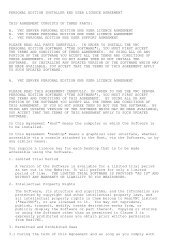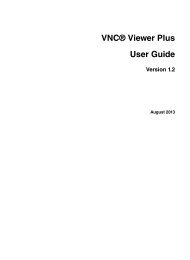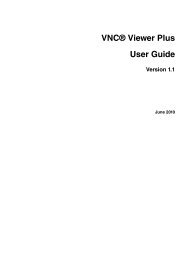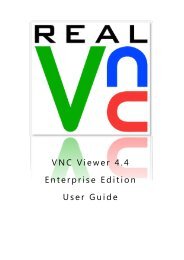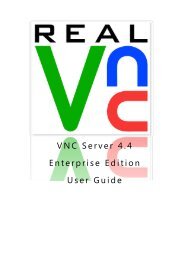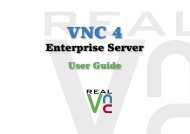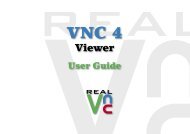VNC User Guide - RealVNC
VNC User Guide - RealVNC
VNC User Guide - RealVNC
Create successful ePaper yourself
Turn your PDF publications into a flip-book with our unique Google optimized e-Paper software.
Chapter 1: Introduction<br />
Principles of <strong>VNC</strong> remote control<br />
To connect to and control one computer from another:<br />
• An application called <strong>VNC</strong> Server must be running on the host computer; that is, on the computer you<br />
want to control. To obtain the latest version of <strong>VNC</strong> Server, download <strong>VNC</strong> from www.realvnc.com/<br />
download/vnc/. Follow the instructions to license it, or consult Licensing <strong>VNC</strong> Server on page 72.<br />
Note: You may be able to control computers running alternatives to <strong>VNC</strong> Server. For more information,<br />
see Connecting to <strong>VNC</strong>-compatible Server applications on page 15.<br />
• An application called <strong>VNC</strong> Viewer must be running on the client computer; that is, on the computer you<br />
are sitting in front of, and want to exercise control from. The latest version of <strong>VNC</strong> Viewer is available to<br />
download from www.realvnc.com/download/viewer/.<br />
Note: You may be able to control computers using alternatives to <strong>VNC</strong> Viewer. For more information, see<br />
Connecting from alternatives to <strong>VNC</strong> Viewer on page 15.<br />
• Host and client computers must be connected to the same TCP/IP network. This can be a private<br />
network such as a LAN or VPN, or a public network such as the Internet. Note that firewalls and routers<br />
must typically be configured before an Internet connection can be established. See Connecting over the<br />
Internet on page 28 for more information.<br />
For information on how to set these applications up, see Getting the computers ready to use on page 11.<br />
Consider the following example environment:<br />
A. Client computer (typically a laptop or desktop) running <strong>VNC</strong> Viewer. B. Client device (handset or tablet) running<br />
<strong>VNC</strong> Viewer for iOS or Android. C. Host computer (typically a workstation or server) running <strong>VNC</strong> Server. D. Router<br />
exposing a public network address for Internet connections to the host computer.<br />
10 <strong>VNC</strong> <strong>User</strong> <strong>Guide</strong>



